REFLECTIONS, QUESTIONS AND ANALYSIS
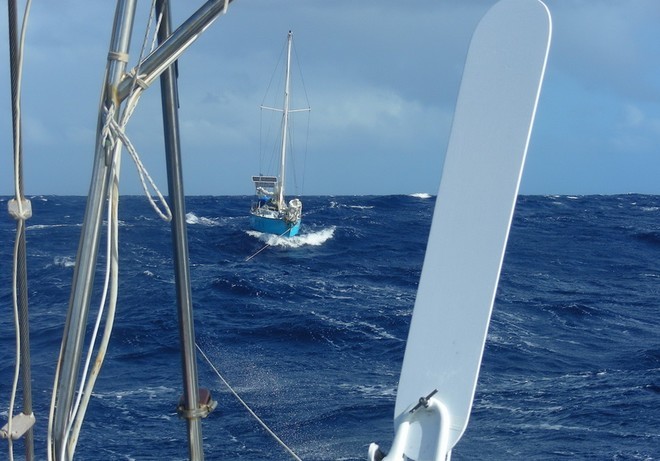 Susanne Huber-Curphey and I have known each other for decades; in fact it has been 25 years even since the last time we spoke face-to-face. It was November 1997 and Susanne had recently stepped ashore in Durban, South Africa, with what must surely be the most unusual delivery of her life: she had just towed her Tony and his Folkboat, which had rudder damage, right across the Indian Ocean. Their safe arrival was not the only cause for celebration either, as this milestone marked the beginning of their partnership for life, two dyed-in-the-wool solo sailors coming together … to carry on each sailing their own boat alone but in company.
Susanne Huber-Curphey and I have known each other for decades; in fact it has been 25 years even since the last time we spoke face-to-face. It was November 1997 and Susanne had recently stepped ashore in Durban, South Africa, with what must surely be the most unusual delivery of her life: she had just towed her Tony and his Folkboat, which had rudder damage, right across the Indian Ocean. Their safe arrival was not the only cause for celebration either, as this milestone marked the beginning of their partnership for life, two dyed-in-the-wool solo sailors coming together … to carry on each sailing their own boat alone but in company.
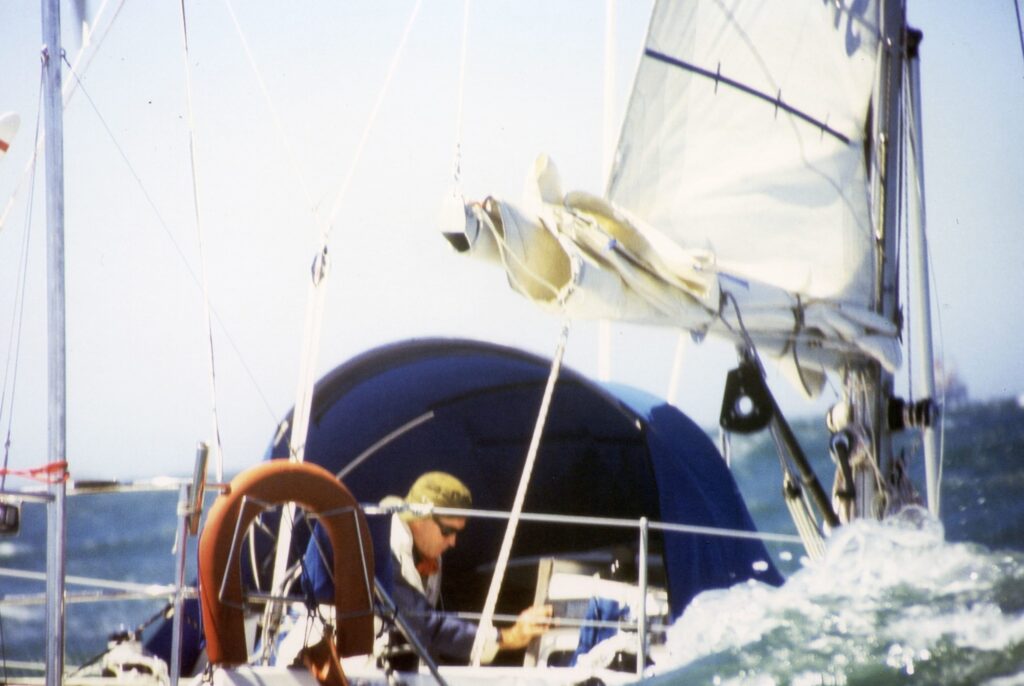 I was pitching my tent in Durban for a few weeks at this time to help my blind friend Geoffrey Hilton Barber prepare for his singlehanded passage to Freemantle.
I was pitching my tent in Durban for a few weeks at this time to help my blind friend Geoffrey Hilton Barber prepare for his singlehanded passage to Freemantle.
Susanne recently wrote to me from Sint Maarten with some observations regarding the GGR.
.
Hallo Peter, I’m also following the GGR 2022 with all its drama and publicity. The long video with the expert boatbuilders discussing the tragic loss of Tapio’s S+S didn’t come to any conclusions, eventually putting the unbelievably quick stern-first sinking down to a mysterious collision. I think you are right that the load placed by the Hydrovane on that elegant but delicate transom could well have been the real cause.
Now we hear Abhilash is cannibalising everything from the heads door to the saloon table to keep his Windpilot supplied with new pendulum rudders. He is sailing right at the limits, or even well beyond them: both wind generators were under water, for example. Perhaps that explains the particular problem he has been having with the self-steering (and he has certainly been having all manner of problems). Do you have any idea what has been causing the self-steering issue? He apparently has two systems on board.
As you know I am a firm believer in the Jordan Drogue in a storm (by a storm I mean Force 10 and above). The drogue removes the risk of these massive, destructive knockdowns that no windvane self-steering system can be expected to cope with. See chapter 14 in the new Heavy Weather Sailing (the 8th edition).
I have only steered by hand in a storm once in almost 300,000 nautical miles. I was to the south of Australia and came close to being rolled. I know that if the Aries can’t manage any more, it will also be too much for me. My view is that nobody should ever feel compelled to steer if they have a good windvane system.
The damage to Patrick’s Aries has still not been explained. Supposedly, the 25mm main shaft slipped out (it’s secured in two ways) without the parts being lost or the gear itself being damaged. Friends of mine who have an Aries recently spoke with Patrick in Lanzarote. He was keeping a low profile.
Why am I writing to you just now? Perhaps because we both know how vital a properly operating and robustly mounted windvane self-steering system is for solo sailors on such a tough 8+ month voyage? And perhaps also just because it has been too long since the last time!
Best wishes, Nehaj-Susanne
Thinking about Susanne’s ideas and questions reminds me that it is probably about time I shared some more of my own observations about the last few months.
It is understandable that the organiser would want to have as eventful a “race” as possible to share with as broad an audience as possible and would want to supply exciting photos and videos to help/remind the editors of the relevant sailing-focused media outlets to report on its progress. The GGR though is increasingly being overshadowed by critical flaws built into the fabric of the event.
I realise that I cannot expect always to be perceived as wholly impartial on this subject, for which reason I have been particularly careful, here as in all my reports on the 2018 and 2022 editions of the GGR, to base my conclusions on objective, verifiable facts.
My book Windvane Report analyses the technical issues raised by the use of windvane self-steering systems in the GGR in considerable detail. That windvane self-steering systems are crucial for GGR skippers must be self-evident to all by now. That self-steering would be vital should always have been obvious to those in the know, which is why I could never understand the ban on electric autopilots in the first edition (using an autopilot in the GGR 2018 would have meant an immediate demotion from the “racing class” to the Chichester Class). We have a combination of pure luck and good seamanship to thank for the fact that Are Wiig and Susie Goodall managed to save themselves when their windvane systems failed. The suggestion is that very few GGR 2018 starters had an autopilot stowed away in a sealed box below deck.
Experience has shown that windvane self-steering systems of virtually all makes ended up creating big trouble at some point. Models from the following companies made it to the start in 2018: Aries, Beaufort, Hydrovane, Monitor and Windpilot.
As I see it, the great weakness of the GGR – a fundamental design flaw, if you will – is the peculiar financial relationship between organiser Don McIntyre and the manufacturer of the Hydrovane systems, an arrangement that appears to have been cooked up to steer as many as possible (perhaps even all?) of the GGR fleet in the direction of a Hydrovane auxiliary rudder system (with the mandatory emergency rudder rule tacked on to provide a little extra persuasion where necessary).
By the time the 2022 GGR started, there were only two makes still in the game:
2 Aries
12 Hydrovane
2 Windpilot
Does that mean the organiser and his sponsor have achieved their objective? Not necessarily…
The longer the event goes on, the more instances we hear about of sailors struggling with systemic weaknesses in the installation and use of auxiliary rudder systems on boats not designed to withstand the very substantial loads they can generate.
This article from November 2022 identifies a few of the areas of concern: – The robustness and dimensional stability of GRP transoms – The risk of hull damage if mounting systems/components prove inadequate – Vibrations and their consequences if reinforcement is insufficient
This is, of course, rather inconvenient for Don McIntyre, who has to try to reconcile the obvious need to look after his sponsor with the equally understandable urge to protect his event. Somehow he has to explain away the slew of retirements/pit stops caused by gear failure during the GGR 2022 without allowing the finger of blame to settle on his financial backer. Carefully crafted press releases publicising his preferred views/interpretations of the various incidents have been one response to this Herculean task, an unwillingness to countenance critical comments on social media apparently another.
Damien Guillouwas blamed for three successive auxiliary rudder shaft failures on the basis that he had allegedly made modifications to the system without having them accepted/approved by the manufacturer/organiser. One of the modifications concerned also featured on Jean Luc Van Den Heede’s Matmut.
Tapio Lehtinen ended up adrift in his liferaft after his yacht suddenly filled with water and sank. There are reasons to believe the mounting arrangement fashioned for his windvane self-steering system might have been responsible, a possibility specifically acknowledged by a Finnish expert in a detailed video investigation into the sinking. Notably, the boat’s purportedly watertight aft bulkheads appear not to have been properly watertight after all as water seems to have been able to flow freely through the centre of the bulkhead.
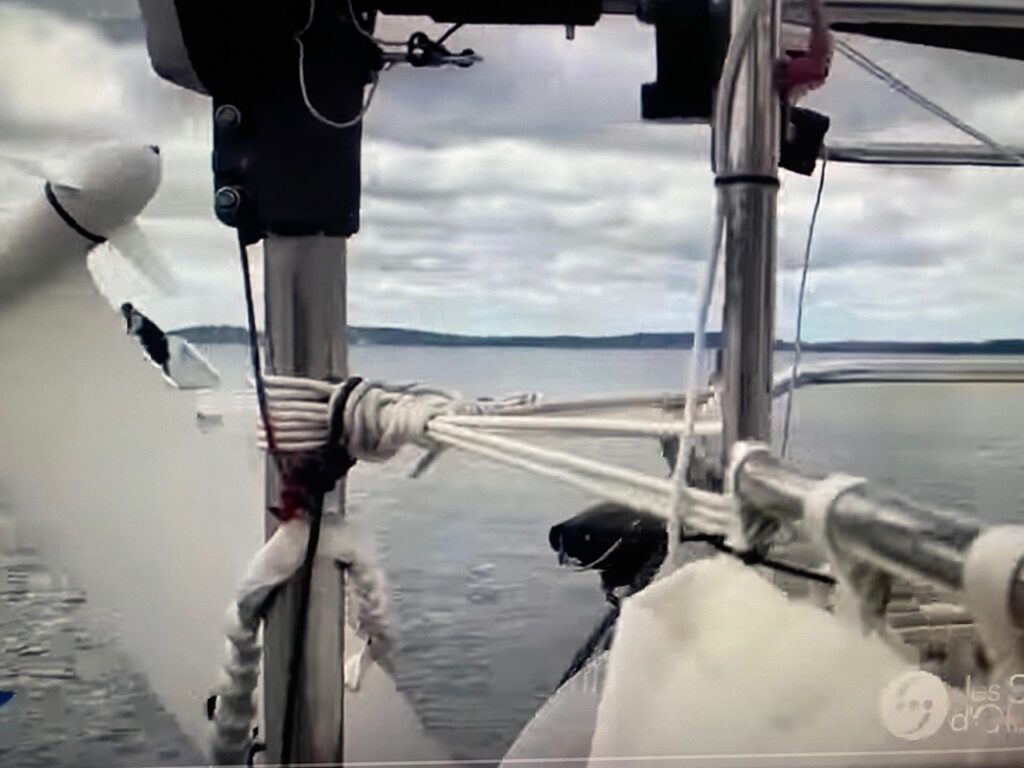
Simon Curwenarrived at the Hobart gate with a pair of lashings helping to secure the upper part of the Hydrovane shaft to his pushpit. The organiser did not ask him about this during the Hobart interview but it clearly suggests the original mounting arrangement with just three asymmetric struts was not up to the job (as JLVDH discovered when Matmut encountered the same problem).
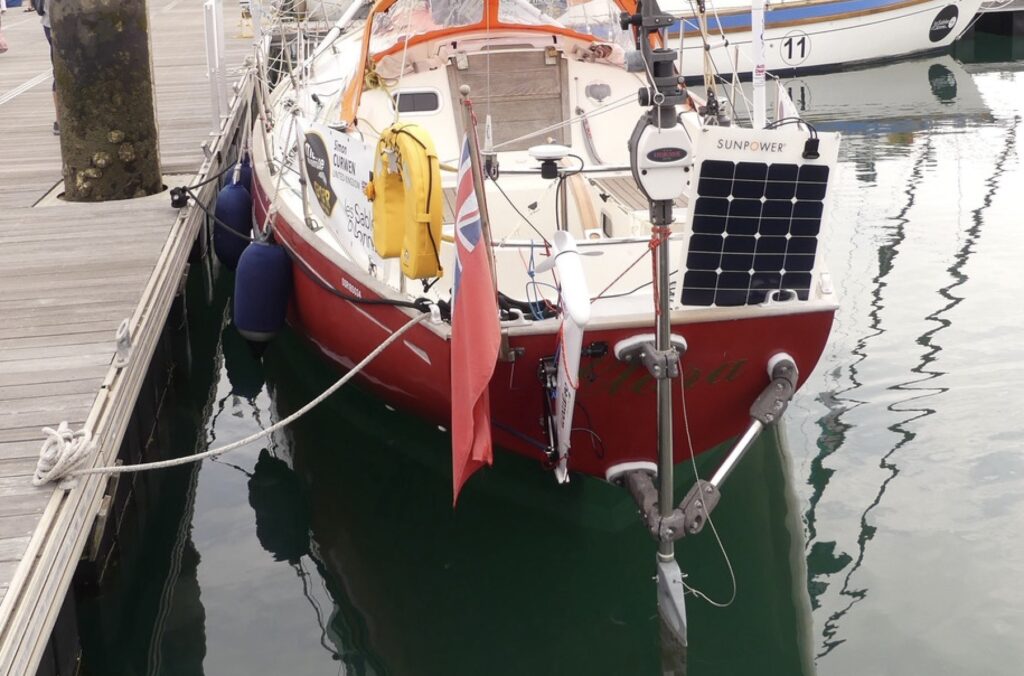
The upper mounting – the very same component used for the lower mounting on Asteria – had obviously worked loose on Simon’s installation.
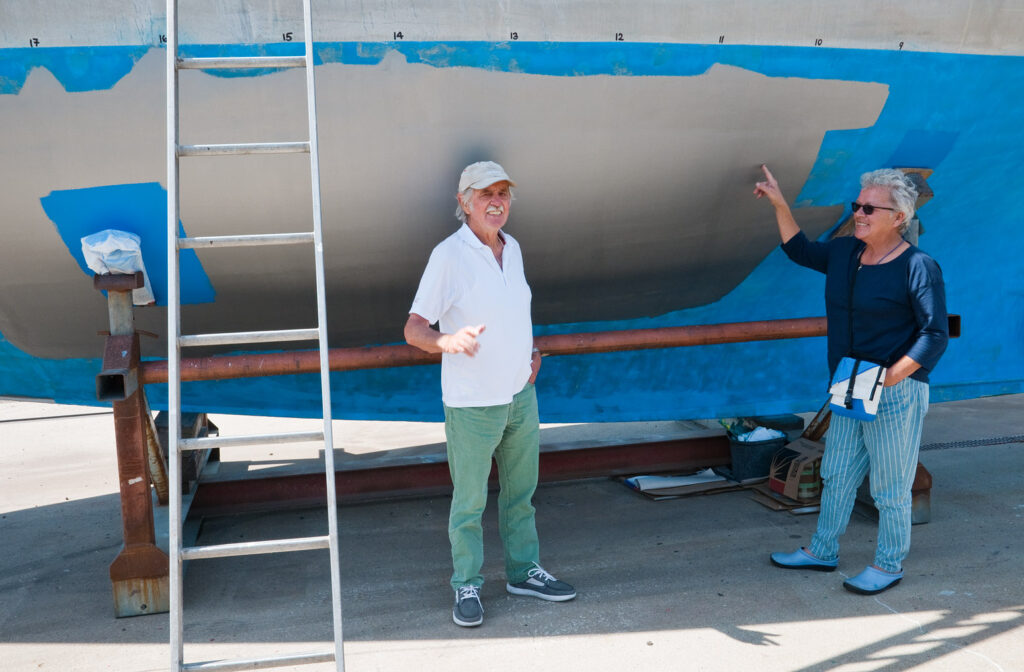 Read about SV Nehaj from Susanne here.
Read about SV Nehaj from Susanne here.
I had some very interesting discussions with naval engineer Kim Klaka in Freemantle during the 2018 GGR. His remarks on storm tactics are well worth reading:
:
Kim Klaka – Storm tactics: some forgotten science
The attrition rate in the recent Golden Globe Race around the world has led to some lively debate about the safety of these old designs compared with modern ocean racers. Those decrying the use of traditional long keel yachts point out two differences compared with modern high performance yachts. Firstly they are much slower, so they have very limited opportunity to get out of the way of approaching storms. This seems irrefutable to me. The second point they make is not nearly so clear cut – they claim that the greater directional stability of a long keel means that if the yacht is surfing on the back of a wave, it will go out of control once it stops surfing. This comment made me recall a piece of work I did many years ago, attempting to explain why ocean sailors adopt different tactics when running with a storm.
As shown by Robin Knox-Johnston’s report in the July 2019 edition of Sailing Today, debate still rages over whether you should deploy drag devices such as drogues and warps to slow a boat down when running before a gale, or whether you should run as fast as you can in order to maintain steerage. Applying a bit of science reveals that this might be a false dilemma, because each technique may be effective at different stages of the storm.
Assumptions and simplifications
The ocean is a mish-mash of waves coming in all shapes and sizes from many directions. That is much too complicated to investigate mathematically, so I follow standard engineering practice and strip it down to something simple enough to understand, but not so simple that it is meaningless. I shall assume we are dealing with a yacht sailing in a regular pattern of waves all from the same direction, none of them breaking over the boat. I also assume we are in deep ocean, not coastal waters (the physics of coastal waves is similar, but the final numbers come out different). We will also only consider the situation where the yacht is travelling in exactly the same direction as the waves – broad reaching brings in extra complications.
Clearly these simplifications lead the reader to think” Yes, but what about all those important other factors that are not being considered?”. My response to that is “Yes, they are important but we have to start somewhere”.
I am not going to examine other storm tactics such as heaving to, lying a-hull, or active steering; they are topics for another article.
Some oceanography
Waves can be described by their height, steepness, length, speed and period. We first need to clarify these terms – see figure 1.
• Period is the time between successive crests passing.
• Height is the vertical distance from peak to trough.
• Length is the distance between successive crests.
• Steepness can be many things, but an easy definition is height divided by length.
• Speed is the speed at which a wave crest moves across the surface. It is important to note that the particles of water in a wave do not move at this speed, it is the speed of the shape of the wave we are talking about here; more on that in a moment.
Fortunately we can reduce this list to just height and speed because length, period and speed are directly linked e.g. if the wave period is known, then speed and length can be calculated. A typical deep ocean wave might have a period of 10 seconds. The oceanographic equations show that such a wave would have a length of 150 metres and travel at 30 knots. Height is not directly linked to length, though there are limits to the height of a wave of given length. A 150 metre long wave would typically have a height of up to around 7 metres, though it could be as high as 14m. If its height is more than about 20m it will break due to its own weight of water. (Of course it will break at a much lesser height if there is a cross-sea).
Let us return to the issue of the speed of the water particles making up the wave. The particles of water do not travel with the wave, they go round in a circle – see figure 2. They travel with the wave at the crest, in the opposite direction at the trough, and vertically at the mid-slope in between. This can be proven mathematically and verified by putting a cork in the ocean and tracking its movement. This circular movement of the water particles is given the term orbital velocity. Our example wave of period 10 seconds and height 7m will have a wave particle (orbital) velocity of about 4kn.
And now the naval architecture
Consider the effect of those orbital velocities on the effectiveness of the rudder. The greater the speed of the water flowing over the rudder, the more steering force it can generate. If a boat is sitting with its stern on the crest of a long wave doing, say, 7 knots, then the flow speed over the rudder will not be 7 kn, it will be 7 kn minus the orbital velocity of the water particles at the wave crest. A 10 second wave of 7 m height, has an orbital velocity of about 4 kn, so when the yacht rudder is on the wave crest, the flow over the rudder is just 3 kn (7 kn minus 4 kn). This is what gives the helm that soggy helpless feel just before the wave gets a hold of the boat. Conversely, the orbital velocities in the trough are 4 kn in the opposite direction, giving you a healthy 11kn flow speed over the rudder if you can maintain boat speed. Let’s park this bit of knowledge about rudder effectiveness for the moment and move onto surging and surfing…..
There is a very old and oft forgotten piece of research (du Cane and Goodrich, 1962), where they measured what happens to boats travelling down waves at model scale in a test basin. They happened to be interested in high speed power boats, but subsequent tests (Kan, 1987) on a range of hull shapes led to similar generalised conclusions. The tests revealed two important findings. Firstly, if a yacht is moving at say, 8 kn in calm water then you put the boat in waves with the same propulsive force from the wind, you can pick up and surf-ride a wave that is about 50% faster than your calm water boat speed. So if you have enough wind force to travel at 8 kn in calm water, that will enable you to surf steadily on a wave travelling at up to 12 kn. (This would be a 4 second, 25 m long wave). The second important finding from the model tests is that the more the boat surges (increases and decreases its speed as the wave passes), the more likely it is to go out of control (usually a broach). So less surge means lower likelihood of broaching.
These two observations are linked, as shown in figure 3. It shows that as the speed of the boat increases it surges more, and when the surge speed momentarily reaches the wave speed, the boat will surf-ride on the wave.
Putting it all together
If you bundle all the above observations together you discover that there are two conflicting requirements – the need for good rudder control means you want boat speed to be high, but the need to reduce surge means you want to slow the boat down. Let us set the two criteria for safe travel as:
• you need at least 2 kn of water flow over the rudder to have control, and
• you must travel at less than 60% of the wave speed to avoid surf-riding.
Taking a 50 kn storm as representative of when things start to get hairy, when you do the sums you get the answers shown in the table below.
Storm duration (hrs) 6hrs 24hrs
Modal wave period (s) 5.6 10.3
Significant wave height (m) 3.3 8.9
Wave speed (kn) 17 31
Orbital velocity (kn) 3.5 5.3
Min. safe boat speed (kn)1 5.5 7.3
Max. safe boat speed (kn)2 10.2 18.6
The results show that at the beginning of the storm the boat speed must be kept below 10.2 kn, which suggests towing warps or a drogue, but not generating so much drag that speed falls below 5.5 kn. Then as the storm develops, the warps should be recovered in order to maintain speed above 7.3 kn if possible; there is little chance of surf-riding in this later part of the storm because it requires a boat speed of more than 18.6 kn to do so. Hence the raging debate about different downwind storm tactics over the years misses the point somewhat; a cruising yacht needs to adopt different tactics for different wave conditions. Specifically, you deploy drag devices at the beginning of a storm when the waves are slow and short, then run at speed later in the storm when the waves have developed into long, fast ones – other things being equal, which they rarely are!
The proof of the pudding
So is this all just theoretical nonsense or is there some real-world evidence to support it? We can test the theory by going through first-hand accounts of successful ocean sailors in conventional cruising yachts. Bearing in mind all the assumptions made in this analysis – non-breaking waves from dead astern etc. – it is difficult to find a first hand account where the two tactics were used at different points in a storm. Nevertheless, there are many reports which do support the general thrust of the theoretical conclusions reached.
Firstly, examine three compilations of first-hand accounts.
Shane
Shane (1990), summarises 71 accounts of yachts using drogues, nine of which are for monohulls deploying drogues off the stern. Two of the most famous (Moitessier, 1969 and Smeeton, 1959) are discussed separately later. Four of the remaining seven accounts support the theory, two disagree with it and one does not have enough detail to inform.
Bruce
Bruce (1999) describes more than 14 storms, some involving several yachts. The majority of reports involve lying a-hull or heaving to, but there are 6 reports of direct relevance to this article. Two of them support the theory, one disagrees, and three are indeterminate.
Knox-Johnston
This recent compilation in Sailing Today summarises 10 incidents in the recent Golden Globe and a further 3 separate incidents. There is limited information about whether each incident occurred early or late in the storm so the results are indeterminate. The experience summarised by Knox- Johnston in the original Golden Globe race on Suhaili was that towing warps at all stages of a storm was effective. However, the winner of the recent Golden Globe, Jean Luc van Heede, did not tow anything during storms in his Rustler 36 Matmut.
1 Must be 2 kn more than the orbital velocity for rudder to work efectively
2 Must be less than 60% wave speed to avoid surf-riding
Now let us examine two detailed famous accounts:
Moitessier
Probably the strongest supporting evidence is that of Moitessier (1969) sailing his yacht Joshua in the Southern Ocean in December 1965. He deployed warps during the first part of the storm, hand steering easily at first but with increasing difficulty as the storm developed. 20 hours into the storm he realised he should not be towing the warps so he cut them loose. The yacht became much easier to steer and survived the storm relatively unscathed. This account is the only one I can find where both techniques are used at the appropriate point in a storm. Whilst Moitessier’s experience might be seen as full vindication of the theory, it should be tempered by the observation that Moitessier was actively steering and also keeping the waves slightly off dead astern.
Smeeton
The pitch-poling of Tzu Hang in the Southern Ocean in February 1957 is one of the most famous storm descriptions in sailing history. They dropped all sail and streamed warps about 8 hours into the storm, hand steering fairly easily. They even managed to film the seas. They continued under trailed warps until about 15 hours into the storm, when they were pitchpoled. We can never know if they would have avoided the pitch pole if they had cut the warps free, but it shows that warps worked to start with but they did not prevent catastrophe later in the storm.
CONCLUSIONS
There is almost certainly an element of sub-conscious cherry-picking in the above examples, but they do provide some support for the theory. What does stand out are the additional influences of active steering, hull shape, wave breaking (steepness) and sailing at an angle to the waves. It also becomes evident that a drag device capable of adjusting the drag according to boat speed could provide a single solution to both sets of storm conditions. All these factors need to be added to this preliminary analysis, but at least we now have a sound scientific basis to work from.
REFERENCES
Bruce P. (1999). Heavy Weather Sailing, 5th ed. Adlard Coles.
du Cane P. & Goodrich G.J. (1962). The following sea, broaching and surging. Transactions Royal
Institution of Naval Architects vol 104 no 2.
Kan M. (1987). Surf-riding of a ship in following waves. Session on Manoeuvrability, 18th International Towing Tank Conference, Kobe, Japan.
Knox-Johnston R. (2019). Rough stuff. Sailing Today, July 2019.
Moitessier B. (1969). Cape Horn: the logical route. Adlard Coles Ltd.
Shane V. (1990) Drag device data base. Para-Anchors International Ltd.
Smeeton M. (1959) Once is enough. Rupert Hart Davis.
Tucker M.J. (1991) Waves in Ocean Engineering, Ellis Horwood. (Section 10.6 in particular)
——————
No matter how well prepared they are and how good their understanding of what the prudent mariner ought to do, the GGR skippers still face the all-important question of when to stop worrying about their (and the organiser’s) desire to reach the finish as quickly as possible and concentrate instead on protecting themselves and their floating home.
Where exactly they decide to draw the line also has big implications for transom ornament suppliers, who are quite likely to find themselves in the firing line when things go wrong even if – like me – they have been quite clear about what can and cannot be expected of their products under extreme conditions.
My unedifying experience in the GGR 2018 with the skipper of Puffin, Istvan Kopar, persuaded me that I really did not want to be involved in the GGR any more. That we have ended up with two Windpilot boats in the current edition nevertheless is down to the strength of my friendship with Jeremy and Abhilash. I had to go back on my word for their sake – and I do not regret it.
When it comes to choosing their windvane self-steering system, sailors contemplating a GGR campaign are left in no doubt as to which solution the organiser would favour. They might be forgiven for having some doubts as to his motivation though, given that his preferred choice of system provider is also his direct sponsor (although voicing those doubts might be unwise seeing as he also has sole jurisdiction over who is permitted to cross the start line). Either they choose to go against the current right from the outset or they go with the flow, pay their money over to the sponsor and hope that everything works out OK in the end.
Taking on an event like this is always going to be a gamble, and a conflict of interests regarding something as essential as self-steering does nothing to improve the odds. I find it particularly jarring that the organiser can favour one particular manufacturer so clearly while still seizing on every opportunity to reiterate that the individual sailor has sole responsibility for his or her decisions. I fail to understand how these two positions are compatible with each other or with the spirit of an event like the GGR. This, I think, is a fundamental design flaw woven into the very fabric of the project.
When the stuff hits the fan, no amount of smooth talking can conceal where the responsibility really lies: cold, hard facts speak with a clarity all their own.
27.02.2023
Peter Foerthmann

































